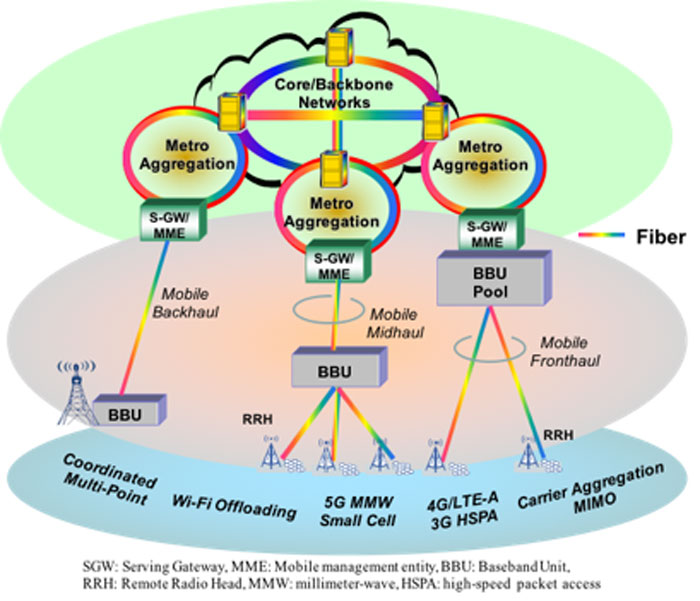AI
AI and Machine Learning: Lighting the Way for Optical Advancements

Key Points
- AI and machine learning are increasingly driving innovation in the optical communication industry, especially in the short-reach optical transceiver market.
- These advancements in AI/ML will not only enhance data centers but also benefit broadband operators by supporting scalable, cost-effective solutions.
One of the key roles that CableLabs plays for our member operators and the vendor community is tracking trends in key areas of the broadband industry. Because the networks operated by our members are predominantly fiber, we are always keeping a close eye on the optical industry — but this year is proving to be an especially exciting one across a range of optical topics.
In this blog post, we explore some of the key topics driving today’s optical industry, focusing on artificial intelligence and machine learning (AI/ML). Let’s dig in.
Short-Reach Optical Transceiver Market
Over the past few years, datacom has surpassed legacy telecom in driving the optical communication industry. However, the rapid development of AI computing is taking center stage and taking over the short-reach optical transceiver market, which has ignited innovation across the industry.
AI/ML is driving the need for increased computing power at an astonishing rate, with company after company announcing newer and more powerful chips in rapid succession. These chips are deployed en masse in data centers, creating rack after rack of computing power. But to harness their full power, they have to be used together. And that requires interconnects, including:
- Graphics processing unit (GPU)-to-GPU
- GPU-to-central processing unit (CPU)/high bandwidth memory (HBM)
- GPU/CPU to frontend and backend switches, and network interface cards (NICs)
Currently, copper cables are employed for all intra-rack 400G and 800G interconnects because of their power, cost and reliability advantages. The question is, when the data rate scales up to 1.6T and 3.2T, and the per-lane rate increases to 200G and 400G, is copper still the right solution? And what about clusters as a chip — multiple racks in a cluster, with a multitude of chips acting together as one — which requires immense amounts of data throughput and very low latency communication between racks?
Based on the work taking place right now, it seems optical technology will be the technology of the future to support these needs.
What Optical Technologies Might Support AI/ML?
A range of technologies are the subject of extensive investigation for potential use in supporting both intra- and inter-rack communication for 200G and 400G per lane, including:
- Vertical-cavity surface-emitting lasers (VCSEL) with multimode fiber
- Silicon photonics
- Electro-absorption-modulated laser (EML) with single-mode fiber
Additionally, in the drive to increase density and flexibility, reduce power consumption, lower cost and reduce latency, members of the industry are looking at different optical transceiver packaging options, including:
- Full-DSP pluggable transceivers
- Half re-timed pluggable transceivers
- Linear-drive pluggable transceivers
- Co-packaged optics solutions
Further, optical circuit switching (OCS) based on micro-electromechanical systems (MEMS) is being implemented for the first time inside data centers by Google, seeking to enable topology reconfiguration, flexible upgrades, network resiliency and traffic grooming.
Liquid cooling is being introduced to keep communication systems running smoother and more efficiently than traditional air-cooled approaches: While liquid cooling is no longer that unusual in computer platforms, this is something very new in optical equipment.
What Does This Mean for the Broadband Industry?
This work will impact the industry in a number of different ways.
Broadband operators are increasingly operating data centers, leveraging their networks and distributed footprint to bring scalable computing closer to customers. AI/ML computing will inevitably be a part of that, and these technological advances will support the operators' ability to deploy powerful, scalable, cost-effective solutions.
Telecom can even take advantage of these new innovations in their own networks, leveraging the immense scale of datacom to keep the costs of these new solutions as low as possible, resulting in a win-win scenario.
Of course, this is just the tip of the iceberg for what’s happening in the optical industry!
These trends are already dominating agendas at industry events, including this spring’s Optical Fiber Conference (OFC) in San Diego — the world’s largest conference and exhibition for optical communications. A tangible energy and excitement flowed through the OFC sessions and the exhibition floor as industry leaders discussed technology innovations and advancements that will power the future.
ECOC 2024
Later this month, I’m an invited speaker at Europe’s counterpart to OFC: the European Conference on Optical Communication (ECOC) 2024 in Frankfurt, Germany. If you’ll be there, join me for three sessions in which I’ll be presenting:
Sunday, Sept. 22
- “Beyond 50G-PON — Can We Still Use IMDD?”
Monday, Sept. 23
- “Advances in the Latest Coherent PON Technology and Industry Specification Development”
Tuesday, Sept. 24
- “Adaptable Modulation and Baud Rates in Coherent TFDM PONs: Towards Versatile High-Speed Access Networks”
SCTE TechExpo24
If you’re attending SCTE TechExpo in Atlanta, join my CableLabs colleagues for several optical- and PON-related sessions. They include:
Wednesday, Sept. 25
- “Practical Strategies for Deploying FTTH” — John Bevilacqua (moderator), Kevin Noll (speaker)
- “A Photonic Future” — Alberto Campos (speaker)
- “Coherent PON” — Matt Schmitt (moderator), Haipeng Zhang (speaker)
Thursday, Sept. 26
- “Operationalizing and Automating PON” — Curtis Knittle (moderator), Jon Schnoor (speaker)
- “Boosting Performance: PNM for Optical Networks” — Jason Rupe (speaker)
Also, visit the CableLabs booth (#1547) on the TechExpo show floor to sit in on new technology demos and learn how CableLabs’ Technology Vision is helping align the broadband industry and advance innovation and technology development. A core focus area within the Tech Vision — Advanced Optics — encompasses our research to ensure that state-of-the-art optics solutions like those discussed here find their way into the evolution of our networks.
Please stay tuned as we continue to look at other advancements taking place in optical technology that the broadband industry should be keeping an eye on.
Events
See You at OFC 2022

The 2022 Optical Fiber Communication Conference and Exhibition (OFC)—the hub of the optical industry and the premier event in fiber communications and networking—will take place March 6–10, 2022, at the San Diego Convention Center in San Diego, California. This year, the event will be presented in a hybrid format that offers both in-person and virtual sessions.
For over 40 years, OFC has been the world’s largest conference and exhibition for optical communications and networking professionals. The event has drawn attendees from all corners of the globe to focus on the latest market trends, technology advances and groundbreaking innovations. The program is truly comprehensive—from near- and long-term research to the latest deployments, from fiber/components to comprehensive systems and networks, and from five-day technical sessions to one-stop-shop exhibitions.
Optical fiber communication technologies are critical to cable operators’ success in supporting broadband, wireless and enterprise connectivity services. Cable operators have long invested in deploying more fiber deeper into their networks.
At CableLabs, our Optical Center of Excellence continues to be at the forefront of developing innovative approaches for high-performance fiber connectivity in cable operators’ networks, including point-to-point and point-to-multipoint transport applications from the network core, in aggregation, at the edge, and to homes. These innovations demonstrate long-term evolution toward a converged network, a roadmap to extend the life of cable’s infrastructure while continuing to lower the cost per bit, and methodologies for provisioning optical connectivity faster and more reliably.
Below is a list of CableLabs optical experts who will address a broad range of industry trends and technologies at the 2022 OFC conference.
Time |
Program |
Sunday, 6 March |
Dr. Jing Wang, Presenter |
Sunday, 6 March |
Dr. Zhensheng Jia, Workshop Organizer |
Monday, 7 March |
Dr. Haipeng Zhang, Presenter |
Tuesday, 8 March |
Dr. L. Alberto Campos, Panel Organizer |
Tuesday, 8 March |
Dr. Curtis Knittle, Presenter |
Thursday, 10 March |
Dr. Mu Xu, Panel Organizer |
Thursday, 10 March |
Dr. Zhensheng Jia, Presenter |
Thursday, 10 March |
Dr. L. Alberto Campos, Presenter |
Thursday, 10 March |
Dr. Mu Xu, Presenter |
We also have a collaborative project with the University of California, Santa Barbara (UCSB) that will demonstrate a novel C-band wavelength selective switch well equipped to handle the demands of scaling access at the edge network. Please join us to discuss how these technologies will shape the future of our broadband network.
In addition to my participation in two of these sessions, I’m honored to have been elected Optica Fellow (formerly Optical Society of America) for outstanding contributions to the development of interoperable coherent optical systems and fiber-wireless converged technologies for broadband access networks. I will be recognized at the OFC Awards Ceremony & Luncheon. I hope to see you there!
The Future of Cable
At CableLabs, we’re committed to inventing new ways to keep people connected and improve their broadband experience. Now, with the 10G Platform initiative in the cable industry, there’s no doubt that optical fiber transport will play an increasingly important role in enabling the delivery of fast and affordable bandwidth for all services, with lower latencies, enhanced reliability and better security in a scalable manner. Over the past few years, CableLabs has successfully developed a series of specifications to enable the development of interoperable transceivers using P2P coherent optics that are access-optimized to address the increasing traffic-aggregation needs of cable and shorter-length distribution networks in terms of capacity, network topologies and deployment scenarios.
Currently, we’re working on a coherent passive optical network (CPON) project to develop a suite of specifications for next-generation 100G single-wavelength PON to enable service providers the ultimate cable connectivity platform and stay ahead of their convergence, business and residential needs. If you’d like to participate in the CPON working group activities, please submit your email request to workinggroups@cablelabs.com.
See you at the 2022 Optical Fiber Communication Conference and Exhibition!

Wired
Everything You Want to Know About Coherent Optics for Access Networks (But Were Afraid to Ask)

The cable industry has been well served by its extensive fiber deployment that took place during the initial hybrid fiber-coax (HFC) buildout. Even though cable operators have answered capacity demand through fiber node-splits in specific high demand scenarios, only recently have operators embarked on deeper-fiber roll-out strategies as part of a comprehensive long-term evolution plan.
The exponential growth in demand for capacity prompted CableLabs to explore how to best use cable’s optical infrastructure resources. This exploration led to research activities for the introduction of coherent optics in the access environment. We’re delighted to announce the publication of the book “Coherent Optics for Access Networks” by CRC Press (Taylor & Francis Group), highlighting many of CableLabs’ research activities.
The book discusses how coherent optics in the access network is re-engineered to simultaneously achieve lower complexity and higher performance afforded by the generous link margins characteristic in shorter links. This instantiation of coherent optics is not only suitable for cable access but also for telco and cellular fiber access networks.
Recent developments in the field of coherent optics for access network applications that will support point-to-point (P2P) aggregation use cases and point-to-multipoint (P2MP) fiber to the user’s passive optical network are examined. Optical industry trends as well as the conventional intensity modulation and direct detection (IM-DD) systems and newly developed advanced direct-detection architectures leveraging four-level pulse amplitude modulation format, Stokes receivers and Kramers–Krönig receivers are also presented.
This book focuses on how to adapt coherent optics technology to the access environment in ways that address major cost challenges, such as simplified transceiver design and photonic integration. An example, is the introduction of full-duplex coherent optics, which enables simultaneous bidirectional transmission on the same wavelength thereby doubling fiber’s capacity. Full-duplex coherent optics is an approach that is feasible to implement in the shorter-link-length access environment.
The book provides economical modeling for aggregation uses cases in comparison with traditional 10G IM-DD DWDM based solutions. Implementation requirements, unique to the access environment, are also provided when introducing coherent optics into access scenarios, including coexistence with existing services and security challenges. Progress on recent-specification development activities is reviewed for many industry organizations that focus on short-distance coherent optics interoperability.
In writing this book, the authors have benefitted from the numerous interactions with experts within the optical telecommunication components and systems community, in particular with the vendor and operator members that contributed to CableLabs’ point-to-point coherent optics specification. This book represents a first look of technological advances in coherent optics, in the interest of future proofing of our access networks.
Favorable coherent component cost-reduction trends are expected to continue, technological advancements will enable higher performance and simpler implementations will make coherent technology more pervasive in the access network so that exponential growth in capacity is achieved. Given the headway gained in specification generation bodies and the development progress of optical component and transceiver manufacturers focusing on shorter link distances, a future with coherent optics in the access network is upon us.

Wired
Forward Error Correction (FEC): A Primer on the Essential Element for Optical Transmission Interoperability

Forward error correction (FEC) has been a powerful tool in the cable industry for many years. In fact, perhaps the single biggest performance improvement in the DOCSIS 3.1 specifications was achieved by changing the FEC being used in previous versions – Reed-Soloman (RS) – to a new coding scheme with improved performance: low-density parity check (LDPC). Similarly, FEC has also become an indispensable element for high-speed optical transmission systems, especially in current coherent optical transmission age.
FEC is an effective digital signal processing method that improves the bit error rate of communication links by adding redundant information (parity bits) to the data at the transmitter side so that the receiver side then uses the redundant information to detect and correct errors that may have been introduced in the transmission link. As the following figure shows, the signal encoding that takes place at the transmitter has to be properly decoded by the receiver in order to extract the original signal information. Precise definition and implementation of the encoding rules are required to avoid misinterpretation of the information by the receiver decoding the signal. Successful interoperability will only take place when both the transmitter and receiver follow and implement the same encoding and decoding rules.

As you can see, FEC is the essential element that needs to be defined to enable the development of interoperable transceivers using optical technology over point-to-point links. The industry trends are currently moving toward removing proprietary aspects and becoming interoperable when the operators advocate more open and disaggregated transport in high-volume short-reach applications.
When considering which FEC to choose for a new specification, you need to consider some key metrics, including the following:
- Coding overhead rate— The ratio of the number of redundant bits to information bits
- Net coding gain (NCG)— The improvement of received optical sensitivity with and without using FEC associated with increasing bit rate
- Pre-FEC BER threshold— A predefined threshold for error-free post-FEC transmission determined by NCG
Other considerations include hardware complexity, latency, and power consumption.
One major decision point for FEC coding and decoding is between Hard-Decision FEC (HD-FEC) and Soft-Decision FEC (SD-FEC). HD-FEC performs decisions whether 1s or 0s have occurred based on exact thresholds, whereas SD-FEC makes decisions based on probabilities that a 1 or 0 has occurred. SD-FEC can provide higher NCG to get closer to the ideal Shannon limit with the sacrifice of higher complexity and more power consumption.
The first-generation FEC code, standardized for optical communication, is RS code. RS is used for long-haul optical transmission as defined by ITU-T G.709 and G.975 recommendations. In this RS implementation, each codeword contains 255 code word bytes, of which 239 bytes are data and 16 bytes are parity, usually expressed as RS (255,239) with the name of Generic FEC (GFEC). Several FEC coding schemes were recommended in ITU-T G. 975.1 for high bit-rate dense wavelength division multiplexing (DWDM) submarine systems in the second-generation of FEC codes. The common mechanism for increased NCG was the use of concatenated coding schemes with iterative hard-decision decoding. The most commonly-implemented example is the Enhanced FEC (EFEC) from G.975.1 Clause I.4 for 10G and 40G optical interfaces.
At the 100 Gbps data rate, CableLabs has adopted Hard-Decision (HD) Staircase FEC, defined in ITU-T G.709.2 and included in the CableLabs P2P Coherent Optics Physical Layer v1.0 (PHYv1.0) Specification. This Staircase FEC, also known as high-gain FEC (HG-FEC), is the first coherent FEC that provides an NCG of 9.38 dB with the pre-FEC BER of 4.5E-3. The 100G line-side interoperability has been verified in the very first CableLabs’ Point-to-Point (P2P) Coherent Optics Interoperability Event.
At the 200 Gbps data rate, openFEC (oFEC) was selected in CableLabs most-recent release of P2P Coherent Optics PHYv2.0 Specification. The oFEC provides an NCG of 11.1 dB for Quadrature Phase-Shift Keying (QPSK) with pre-FEC BER of 2E-2 and 11.6 dB for 16QAM format after 3 soft-decision iterations to cover multiple use cases. This oFEC was also standardized by Open ROADM targeting metro applications.
Although CableLabs has not specified 400G coherent optical transport, the Optical Interworking Forum (OIF) has adopted a 400G concatenated FEC (cFEC) with soft-decision inner Hamming code and hard-decision outer Staircase code in its 400G ZR standard; this same FEC has been selected as a baseline proposal in the IEEE 802.3ct Task Force. This 400G implementation agreement (IA) provides an NCG of 10.8 dB and pre-FEC BER of 1.22E-2 for coherent dual-polarized 16QAM modulation format specially for the Data Center Interconnection (DCI).
The following table summarizes performance metrics for standardized FEC in optical fiber transmission systems.

CableLabs is the first specification organization to demonstrate 100G coherent optics interoperability with a significant level of participants. Please register for our next coherent optics interoperability testing.

Wired
What is Full Duplex Coherent Optics?

A brand new innovation, Full Duplex Coherent Optics uses the same wavelength, in two different directions, over the same fiber at the same time. As a result, Full Duplex Coherent Optics technology supports over 200 times more capacity compared to non-coherent digital transmission over a single fiber. This makes Coherent Optics technology well suited for deployment in many more cable access network fibers. Watch our video to see how this technology will significantly increase the value of the currently deployed fiber infrastructure.

Click below to learn more about Full Duplex Coherent Optics.

Wired
Doubling up on Fiber Capacity: A Winning Strategy for Full Duplex Coherent Optics

During our 2017 Winter Conference, CableLabs announced the launch of the point-to-point (P2P) Coherent Optics specification project, potentially multiplying the capacity of each existing cable access network fiber by over 100 times and possibly indefinitely deferring new fiber builds on existing routes. Now, a new CableLabs innovation, Full Duplex Coherent Optics:
- Doubles the bi-directional capacity of each fiber
- Multiplies the capacity of each existing access network fiber by over 200 times
- Simultaneously makes Coherent Optics technology well suited for deployment in many more cable access network fibers
Why CableLabs Began the Coherent Optics Project
Most cable operators have a somewhat limited fiber count between the headend and the fiber node, so maximizing the capacity provided by this scarce resource has real economic advantages for cable operators. Getting more capacity out of the existing fibers can eliminate the need to dig more trenches to lay more fiber. This allows operators to best leverage the existing fiber infrastructure to withstand the exponential growth in capacity and services for residential and business subscribers.
Transport Methodologies
There are two fundamental topologies to achieve bidirectional P2P coherent transport:
- dual-fiber
- single-fiber
According to a recent operators survey, 20 percent of existing cable access networks use a single-fiber topology. That means that downstream and upstream transmission to nodes takes place on a single strand of fiber. It is estimated that over the next 5 years, this number will grow to 60 percent. Therefore, bidirectional transmission over a single fiber is needed for coherent signals to support single-fiber topologies and to facilitate the redundancy of optical links.
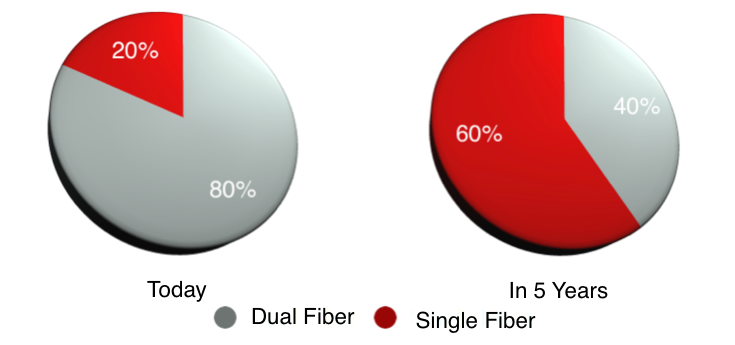
The Dual-Fiber Approach
Today, achieving bidirectional transmission in an optical domain with a single laser requires two fibers. This is the standard practice using today’s coherent optical technology. One laser in a transceiver performs two functions:
- as the optical signal source in the transmitter
- as the reference local oscillator signal in the receiver
Because of the use of the same wavelength from the same laser, a second fiber must be available for the other direction—one fiber for downstream and a second fiber for upstream.
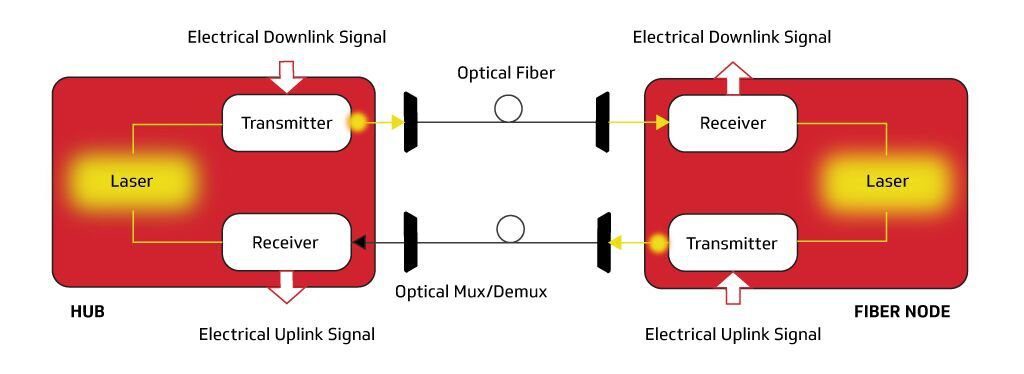
The Single-Fiber Approach
The second typical approach is to use a single fiber but transmit at different frequencies or wavelengths, similar to the upstream and downstream spectrum split that we implement in our HFC networks. To accomplish this frequency/wavelength multiplexing approach, two lasers operating at different wavelengths are needed. Wavelength multiplexers and demultiplexers following a wavelength management and allocation strategy are needed to combine these different wavelengths over the same fiber. The second laser ends up costing a lot more than money—increasing power consumption, operational complexity, and transceiver footprint.
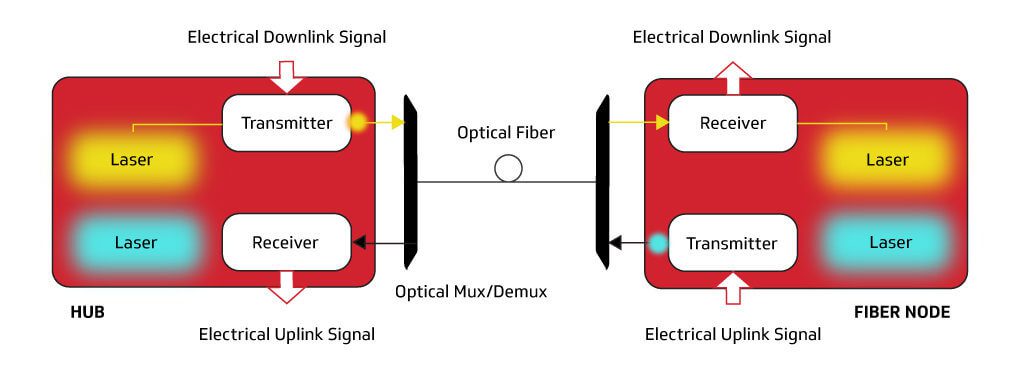
CableLabs’ Full Duplex Coherent Optics Approach
CableLabs proposes an alternative method to achieve full duplex coherent optics. We leverage two optical circulators on each end in a special configuration. The circulator is a low-cost, passive, but directional device—much like a traffic roundabout for cars, but this is an optical roundabout. Instead of using two fibers, a single fiber is connected for bidirectional transmission. Most importantly, instead of using two lasers, a single laser is employed for single-fiber coherent systems.
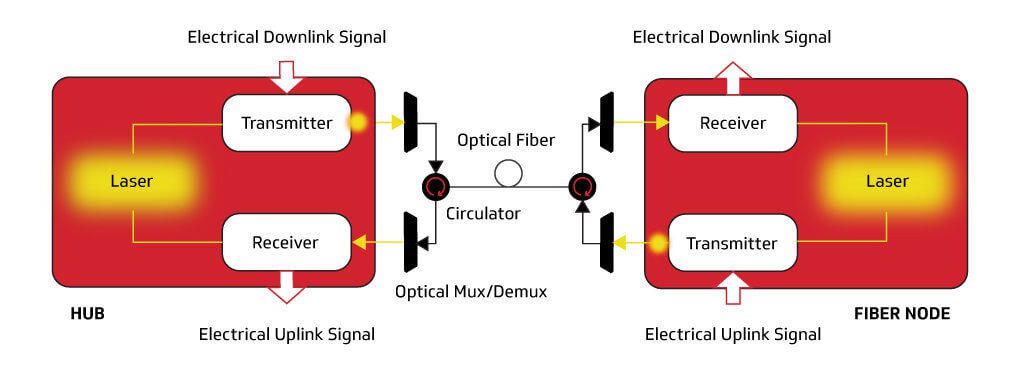
How Does It Work in a Cable?
Many scenarios in cable focus on the access environment with limited transmission distances. Unlike backbone and metropolitan coherent optical networks, access networks don’t require multiple directional optical amplifiers in cascade. By definition, the introduction of directional components hampers bidirectional transmission.
When dealing with coherent signals, we have much higher Optical Signal to Noise Ratio (OSNR) sensitivity and higher tolerance to the impairments from the spontaneous Rayleigh backscattering than intensity-modulated systems. In addition, the threshold of the stimulated Brillouin scattering (SBS) nonlinear effect is much higher because of the nature of phase-modulated signals on the reduction of optical carrier power and the increase of effective linewidth.
With this new dimension of direction-division multiplexing (DDM) in the optical domain, any coherent wavelength can be used twice, once in each direction, thus doubling the whole fiber system capacity. This full duplex implementation is not bandwidth-limited. It works for 100G, 200G and future 400G. It is also not wavelength-selective. It works for short wavelengths and for long wavelengths, and it would cover not only the entire C-Band but, with different optical sources, the entire fiber spectrum. All these features have been experimentally verified in CableLabs’ Optical Center of Excellence (OCE) over distances of up to 100 kilometers.
Impacts/Benefits of Full Duplex Coherent Optics
Full duplex coherent optics will significantly increase the value of the currently-deployed fiber infrastructure. It has been implemented in an elegant way, without the requirement of redesigning new chips for digital signal processing. This scheme can be seamlessly incorporated into the ongoing CableLabs’ P2P Coherent Optics specification effort, which will be issued in mid-2018.
Dr. Alberto Campos, a CableLabs Fellow, also contributed to this article.
--
Interested in learning more about our point-to-point (P2P) Coherent Optics specification project? A follow-up video containing more information on the technology will be posted next week. Click below to join our working group.

Wired
It’s Only Wireless for THIS long

Why the underlying fiber network is critical to mobile communications. -- The explosion in popularity of the mobile game Pokémon Go has triggered unprecedented attention on virtual reality (VR) and augmented reality (AR). Many believe that Pokémon Go is just the first step into the fully-immersive VR and AR applications, which, from a bandwidth demand perspective, are on the high end of the Internet of Things (IoT) connections. By the end of this decade, analysts predict that 50 billion IoT sensors will connect to mobile networks consuming 1000 times as much data as today’s mobile gadgets alone. Along with cloud, machine to machine, and new video streaming applications, the underlying network infrastructure that enables such constant high-quality connectivity is critical to ultimate user experiences. None of the existing radio access technologies will be able to individually provide the capabilities to effectively meet market demands. The next generation 5G mobile system is being designed specifically to support this vision of satisfying the increasing demand for higher data rates, lower network latencies, better energy efficiency, and reliable ubiquitous connectivity.
However, the success of 5G will not just be about new wireless technologies! The deployment of 5G technologies will be dependent on the ability of the wireline transport network connected to the radio access networks (RANs). This is because all the air bits will be transported from the wireline systems, most likely high-speed fiber optic networks. The network architecture and topology are evolving too (see Figure) and we expect to see a proliferation of small cells deeper in the network closer to the end-user. Small cells have a range of 10 to 200-meter cell radius within urban and in-building locations, to 1 or 2 km in rural areas. Centralized or Coordinated-RAN solutions, where the baseband units are placed together and share information at a centralized location, require the extremely high speed and low latency only available using fiber networks. The reality is… in mobile networks the bits are only air bits for a very short part of their life!
Historically, the transition to new mobile technologies has resulted in the need for a fourfold to fivefold increase in backhaul capacity. With the advancement from 3G to 4G, RANs reached a capacity of 1 Gb/s to 10 Gb/s per cell. If you consider the effective throughput for each user and the deployment of multi-antenna technologies, future 5G RANs will require ten times the backhaul capacity of today’s networks. If 5G network technology is deployed at scale, wireless networks will have to xhaul (backhaul, midhaul, and fronthaul) massive amounts of data between cell sites and core networks.
Compared to alternatives like mm-wave self-backhauling, deploying optical fiber provides a superior technical solution due to bandwidth scaling, low and deterministic latency and jitter, and high system reliability. Optical techniques can also provide the leverage to enhance inter-cell coordination, achieve wide network coherence, and also decrease timing jitter in high order vector modulation and simplify remote radio head architecture. In this sense, fiber is not only the transmission pipe, it can integrate with wireless systems for end-to-end seamless networking purpose to affect network control and power efficiency, minimize latency, provide network system protection and restoration, and decrease digital data processing overhead.
Fiber and optical transport technologies are expected to play more and more important roles in the RANs to meet the aggressive performance goals of 5G. CableLabs is heavily involved in both the wireless and wireline portions of RANs. On the wireless portion, CableLabs is contributing to the ongoing formation of 5G technologies and network architectures including multi-gigabit wireless transmission over millimeter-waves and dense mobile and fixed wireless access. On the wireline portion, CableLabs is exploring new fiber optic technologies that increase capacity and lower latency, while also leveraging the unique characteristics of Hybrid Fiber Coax networks. Leveraging our expanded efforts toward university research, we are exploring the melding of wireless and wireline through collaboration with the National Science Foundation’s Fiber-Wireless Integration and Networking (FiWIN) center led by Georgia Tech.


